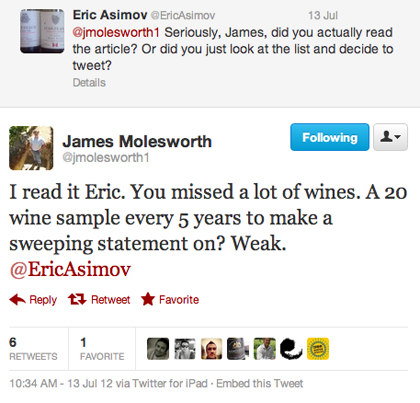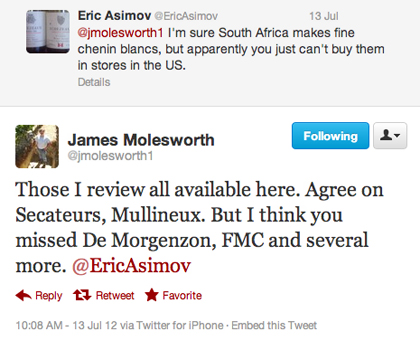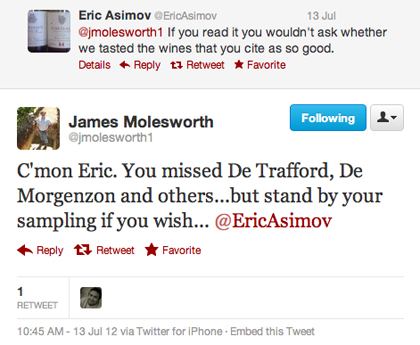South African Chenin blanc and wine twiticism
In today’s NYT, Eric Asimov writes about their tasting panel’s assessment of Chenin Blanc from South Africa (“A Wine That Isn’t What It Used to Be”). He says they found little to like, perhaps because of “difficult” vintages of 2010 and 2011, high yields or the unforgiving nature of screw caps. This is a change from five years ago when he found several wines in the category worth recommending.
Even though the story is in today’s print paper, it went online last Thursday. Last Friday, James Molesworth, who reviews South Africa wines (among others, including the Loire) for Wine Spectator, challenged Asimov’s findings on Twitter, saying, “You missed a lot of wines. A 20 wine sample every 5 years to make a sweeping statement on? Weak.” They went back and forth a few times (though Asimov’s July 13 tweets have oddly disappeared from his feed). Molesworth tastes and reviews many more than 20 chenin blancs from South Africa every year as he adopts a more comprehensive approach.
It’s rare to see wine critics disagree publicly. What do you think led to their different views of the category, their methodology or taste preferences? While the Time’s sampling strategy may miss some good wines in any given column, this seems to be a matter of taste. One of the wines that Asimov mentioned in the column, the 2009 FMC from Ken Forrester, wasn’t recommended since he (and the panelists?) found it “so sweet, oaky, unbalanced and fatiguing.” In reviewing the same wine, Molesworth gave it 93 points, calling it “Ripe and lush, with delicious creamed pear, ginger, heather and fig kept honest by fresh acidity that’s well-embedded on the toasty finish…Gorgeous.” So it seems like different strokes for different folks. Which is fine. Because even if scores seem to impart a sense of objectivity to a wine, wine tasting and enjoyment remain exercises in subjectivity. Which, of course, makes for good discussion.







On July 18th, 2012 at 2:51 pm ,bill marsano wrote:
“A 20-wine sample every 5 years”–It’s awfully hard to argue w/Molesworth on this point. I like the idea of wine critics disagreeing publicly, but they should be forced to work out their differences in cage fighting.
On July 18th, 2012 at 10:49 pm ,RobinC wrote:
I think that Eric’s was an anomalous tasting that warrants another look before too long.
On July 18th, 2012 at 11:11 pm ,Wino wrote:
Molesworth is right. The Times does mostly lame tastings that are as far from comprehensive as can be imagined. Then Asimove makes sweeping generalizations. Weak, very weak indeed. And what is Florence Fabricant doing on the panel? Her wine knowledge is, well, um…
On July 19th, 2012 at 12:30 am ,Julien wrote:
It is therefore important that the consumers understand that there isn’t only one critic who they should listen to, but many wine professionals with different points of view. If they want to rely on these people to buy wines, they should know which one’s taste is more likely to suit him/herself. For instance, there are often important ratings differences between american tasters (Wine Spec, Wine Advocate…) and European counterparts (Decanter, RVF, Jancis Robinson…).
On July 19th, 2012 at 8:02 am ,Terroirist: A Daily Wine Blog » Daily Wine News: Wine Blog Awards wrote:
[…] Blake Gray and Dr. Vino chime in on the recent Twitter showdown between New York Times wine critic Eric Asimov and Wine […]
On July 19th, 2012 at 8:30 am ,Joel Goldberg wrote:
As an admirer of multiple vintages of Forrester’s FMC, Asimov’s take was more annoying than anything. He’s free to personally dislike any given style, but one expects more from critics in major publications than to dismiss a serious wine with a glib string of tired adjectives. This is a label that makes an intentionally strong stylistic statement — one that Molesworth nailed in his description.
On July 19th, 2012 at 10:17 am ,GREG DE BRUYN CWM wrote:
Not sure what’s going on here. Maybe a dysfunctional panel. We get them
sometimes, when a prevailing voice skews the tasting for everybody. I think
I’ve tasted all the wines he lists, but there is no way on earth I would put
MAN or La Capra on the same planet as the Raats or Game Reserve, although he
does seem well-disposed towards the Swartland Revolutionaries. As a member of the Platter Wine Guide panel, I taste these
wines regularly and I really can’t support his theories about a decline in
quality. If he liked them 5 years ago and he doesn’t now, I think the
problem is with his palate. There may well be cropping and manipulation
issues with the lower labels, but definitely not with the elite producers he’s listed.
On July 19th, 2012 at 11:31 am ,Dave Erickson wrote:
From Asimov’s column:
“Has my taste changed? Or have the wines? Or was this an anomalous tasting that warrants another look before too long?”
…so what’s everybody’s problem? He’s not exactly claiming to be authoritative.
On July 19th, 2012 at 12:45 pm ,What to drink: 2011 Dry Creek Chenin Blanc | What's in the bottle? wrote:
[…] Asimov vs. Molesworth: the Thrilla in Vanilla […]
On July 20th, 2012 at 3:36 am ,Tai-Ran Niew wrote:
@DaveErickson has got it spot on!!
The reason why Asimov is worth reading, is because he actually thinks. He understands the limitation of what he does and openly discusses it.
The facts were he tasted 20 wines and he did not like a lot of them. The facts were they are supposed to be the top producers. In any wine region, that result would have been strange … something is wrong. He leaves the topic open for discussion. End off. Why is that so difficult to accept?
If he is allowed to dislike what he does not like, surely he should be allowed to air his views without being attacked?
Interestingly, because of his article, I am even MORE inclined to taste SA Chenin Blancs, to see if there is something wrong. Otherwise, I would have just assumed they were perfectly fine and continued to taste Vouvrays …
On July 20th, 2012 at 4:23 am ,gabe wrote:
I’m going with Asimov on this one. While I am sure they make good wines in South Africa, I’ve had bad luck finding them.
I haven’t tasted a ton of South African wines; but I haven’t tasted a much Austrian Gruner or Mosel Riesling or New Zealand Sauv Blanc, and those usually deliver.
Maybe it’s just a matter of availability. Maybe it’s bad luck. Maybe the next SA Chennin I taste will change my mind. But I’m not surprised that somebody went to a SA Chenin tasting and didn’t find anything they liked
On July 23rd, 2012 at 3:36 am ,Wino wrote:
One problem with Asimov’s panels is that the guests are almost always hipster sommeliers or retailers who have extremely strong prejudices, especially against new world wines. You can bet that the whole time they were talking about how great Huet and Foreau and Chidaine are and how there’s no way there can be good Chenin outside Montlouis and Vouvray blahblahblah etc. Look at their lists or shelves sometime and see for yourself how narrowminded and predictably hipster many of them are. But Asimov likes to build up his own hipster wine resume so no surprise that he picks who he does to join in.
On July 23rd, 2012 at 6:01 pm ,Pedro Dias wrote:
@Wino: *Of course* there’s good Chenin outside Montlouis and Vouvray: there’s Savennieres.
You can call it prejudice; I call it judgment, since I’ve done an awful lot of drinking to get to it. The fact remains that I have found no Chenin Blanc from anywhere outside the Loire that comes close to ringing my bell. And South African Chenin Blanc has been especially consistently off the mark, for my palate.
On July 26th, 2012 at 12:19 pm ,Dr. Vino wrote:
Hi Wino,
Interesting that you bring up the people that Asimov tastes with. I’m confused as to their role. Fabricant et al always get one quote in the tasting panel stories to reflect their views, but when Asimov kindly came to talk to my NYU class six years ago, he said that the scores and notes were solely his own and not a compilation of the comments or a vote of the group. Here’s the link:
http://www.drvino.com/2006/12/08/decanting-critic-eric-asimov/
Frank Prial really didn’t like the tasting panel format, which was introduced toward the end of his time as wine critic. He told me once that the Times doesn’t send multiple reviewers to a Broadway show, for example. He also said that the tasting panel was the creation of former executive editor Howell Raines in response to the WSJ’s “Dow Jones TKTK Index” in which John and Dottie gave a short list of recommended wines. In a way, it’s interesting that the Times tasting panel outlived the Dow Jones Wine Index reviews. But that column does seem formulaic often times (lead with a few general grafs of intro; add “Florence Fabricant and I were joined by…”; have a few quick hits on the wines.) But it, no doubt, provides the actionable information that wine consumers seem to crave and when I check in with the col, the recs seem quite solid on the whole.
I do think that an explanatory footnote in the online and mobile editions about how the wines were selected and procured would be helpful. Ditto, whether the star ratings and TNs are Asimov’s alone or a compilation (and if they remain his alone, then I guess Prial’s point about why the TImes invites the guests should be addressed).
On July 30th, 2012 at 6:59 pm ,Chuck Hayward wrote:
From Bill Marsano above:
“I like the idea of wine critics disagreeing publicly, but they should be forced to work out their differences in cage fighting.”
Prefer a wine journo version of Celebrity Death Match myself…